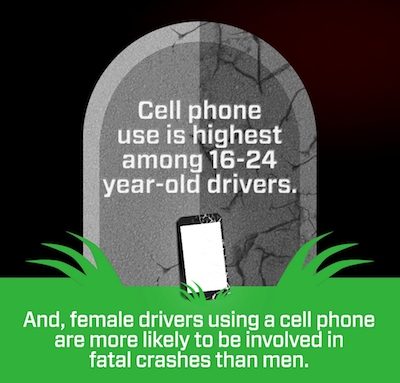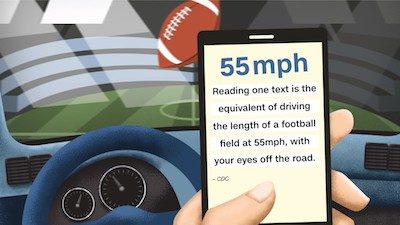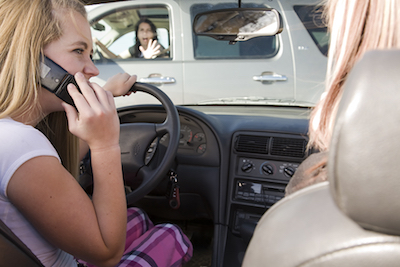By Greg Zyla
Last week we updated our yearly report on “The continuing Saga of young Joe,” a 26-year-old who lost his life in an alcohol related single car accident in his 1970 Chevelle SS454.
This week we follow up with how Joe also became a statistic in the National Highway Safety Administration (NHTSA) group of fatalities filed under “distracted driving.” We’re also again including info on aggressive driving, another potentially deadly form of driving.
Personally, I experienced a near head-on collision a few months back due to a driver who was looking at her phone instead of the road ahead. I was driving to a nearby food store when a car like mine, a GMC Envoy, was coming directly at me. At the last second I had to swerve to the right side of the road, luckily missing a major accident. This driver was clearly looking at her phone and didn’t realize her error until my vehicle was alongside hers. (Yes, that’s close.)
Back to Young Joe.
Last week Joe was answering his smart phone when he was unable to negotiate a sharp curve at a high speed. Thus he adds his name to the distracted driving category of accidents that have grown to over 20% of all accidents reported, both fatal and non-fatal. Sadly these numbers are rising as the youth demographic, already addicted to texting and cell phone use, receive their driver licenses every year.
Unfortunately, most of the National Highway Traffic Safety Administration (NHTSA) “distraction – affected crashes” data is very troubling. The organization lists “distracted driving” as any driver that is texting, using a cell phone, or eating and drinking while driving. Other forms of distraction include excessive talking to passengers, grooming oneself, and even adjusting car stereo systems.
However, NHTSA stresses that sending and receiving text messages requires visual, manual and cognitive attention, and is by far the most alarming distraction drivers engage in regularly.
 Further, NHTSA says that more than an estimated 70% of teens and young people admit they have composed and sent text messages while driving, and now nearly 80% of teens and young adults say they have read messages while driving. Every driver on the road today surely encounters drivers weaving on the road while using their cell phones.
Further, NHTSA says that more than an estimated 70% of teens and young people admit they have composed and sent text messages while driving, and now nearly 80% of teens and young adults say they have read messages while driving. Every driver on the road today surely encounters drivers weaving on the road while using their cell phones.
Obviously texting is here to stay as individuals communicate via these multi-task cell phones daily. Currently, government stats conclude that every month some 170-billion text messages are sent to the U.S., Guam, and Puerto Rico territories.
Additionally, NHTSA information indicates that driver distraction continues to be a significant problem given the difficulty of proof and a driver’s reluctance to admit to texting and phone distractions, lack of witnesses, or death of the driver. NHTSA believes the actual number of distracted crashes could be much higher than the estimated 400,000-plus injured in distraction-affected crashes the last few years.
The U.S. Department of Transportation (DOT) also assists in leading the effort to stop texting and phone use while driving. Starting back in 2009, numerous national distracted driving summits have and are being held resulting in the ban of texting and cell phone use for all drivers, not just commercial as previously reported two years ago.
According to NHTSA, the age group that produces the highest number of distracted drivers is, not surprisingly, the under-20 driver where 16% are involved in fatal crashes identified as distracted.
Further, the Center for Disease Control and Prevention (CDC) found that 39% of high school students who drove in the past 30 days texted or emailed while driving on at least one of those days.
The CDC also found that students who texted or emailed while driving were also more likely to not wear a seat belt. These same students were also more likely to drive after drinking alcohol, according to the CDC.
 Here are some additional facts and recommendations about distracting driving:
Here are some additional facts and recommendations about distracting driving:
1. Five seconds is the average time your eyes are off the road while texting. When traveling at 55-mph, that’s enough time to cover the length of a football field blindfolded. (CDC)
2. Some 10% of all drivers 15 to 19 years old involved in fatal crashes were reported as distracted at the time of the crashes. This age group has the largest proportion of drivers distracted at the time of the crash. (NHTSA)
3. At any given daylight moment, approximately 685,000 drivers are using cell phones or manipulating electronic devices while driving, a number that has held steady since 2010. Experts feel this number will rise and most recent stats found that 4,000 were killed in distracted driving accidents for a 12-month period. (NHTSA)
4. More than half (53%) of all adult cell phone owners have been on the giving or receiving end of a distracted walking encounter, (like walking into oncoming traffic at intersections or into a decorative water pond in the center of a shopping mall). (PEW Research)
5. The National Safety Council (NSC) claims that distracted driving is the leading cause of fatal crashes, and more than 40% of all workplace fatalities involve transportation incidents. (U.S. Bureau of Labor Statistics)
6. Teens can be the best messengers with their peers, so we encourage them to speak up when they see a friend driving while distracted. Have friends sign a pledge to never drive distracted, to become involved in their local Students Against Destructive Decisions chapter, and share messages on social media that remind their friends, family and neighbors not to make the deadly choice to drive distracted. (NHTSA)
We’ll end these holiday columns with a note from the insurance website at www.thezebra.com dealing with texting while driving. The Zebra did a survey last year indicating that eight of every 10 Americans agree that texting and driving is an addiction.
Aggressive driving plays a role in 56 percent of all fatal crashes in the U.S., according to a study conducted by the Insurance Information Institute, while the AAA Foundation attributed more than 200 murders and 12,000 injuries to road rage over a seven-year period.
What’s more, the level of tension on the nation’s roadways has increased while overall traffic has been reduced because of pandemic-fueled business closures and work / learn from home policies. A recent study conducted by The Zebra in Austin, Texas determined that while 35% of the population is logging fewer miles these days, one in five drivers is experiencing more roadway frustration now than prior to COVID’s roadblocks. A whopping 95% of respondents said they’ve observed road rage or aggressive driving, while 64% admit to the behavior.
In addition to paying fines and court costs, The Zebra found that motorists being cited for reckless driving will see their annual insurance premiums skyrocket by an average of $906, and far more in some states.
Compared to The Zebra’s last road rage survey, drivers feel they are “more triggered” across the board as far as what frustrates them. Not surprisingly, the survey found that the most common source of anger (63%) is distracted drivers.
Further, aggressive driving and road rage is getting worse according to The Zebra. Honking a vehicle’s horn to express anger or frustration is the most self-reported aggressive behavior, followed by yelling / cursing at another driver or pedestrian (24%).
In The Zebra’s survey, 60% of drivers said they deal with frustration by listening to music. Other top tactics include yelling or cursing, waiting until the feeling goes away, or driving a different route.
Experts say the best way to respond when another driver seems to be venting his or her anger in your direction is not to react at all. If another driver cuts you off or is otherwise driving aggressively, slow down and give them room to pass. Do not respond with obscene gestures. If you inadvertently cut off another driver, try to apologize by making a suitable hand gesture.
Perhaps adding fuel to the proverbial fire, The Zebra found that 27% of motorists admit to keeping a weapon in their car for personal protection (knife, pepper spray, a club, etc.), with 8% packing a firearm while driving. Think about that the next time you decide to flip off another driver for whatever vehicular infraction irks you.
We need to take advantage of the campaigns available, starting in grade school, to implement and help curb phone addictions. Educators are urged to contact the NHTSA for available program materials and videos to address the problem before students receive their driver permits.
Drive safely and have a happy Christmas holiday season and New Year. Thanks DOT, NHTSA, NSC, NOPUS, CDC, Pew Research, The Zebra and the AAA for these statistics, graphics and estimates for our yearly safe driving columns.
(Greg Zyla is a syndicated automotive columnist. He welcomes reader questions and comments on collector cars, motorsports, and auto nostalgia at 303 Roosevelt St., Sayre, Pa. 18840 or by email to greg@gregzyla.com.)



Be the first to comment on "Cars We Remember / Collector Car Corner; The Saga of young Joe Part II: Texting, aggressive and distracted driving 2023 "